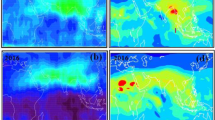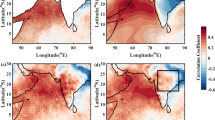Abstract
The Indian summer monsoon is influenced by numerous factors, including aerosol-induced changes to clouds, surface and atmospheric heating, and atmospheric circulation. Most previous studies assessing the effect of aerosols on monsoon rainfall have focussed on the local impact of aerosols on precipitation on monthly to seasonal timescales. Here, we show that desert dust aerosol levels over the Arabian Sea, West Asia and the Arabian Peninsula are positively correlated with the intensity of the Indian summer monsoon, using satellite data and models; a lead–lag analysis indicates that dust and precipitation vary in concert over timescales of about a week. Our analysis of global climate model simulations indicates that by heating the atmosphere, dust aerosols induce large-scale convergence over North Africa and the Arabian Peninsula, increasing the flow of moisture over India within a week. According to these simulations, dust-induced heating of the atmosphere over North Africa and West Asia rapidly modulates monsoon rainfall over central India.
This is a preview of subscription content, access via your institution
Access options
Subscribe to this journal
Receive 12 print issues and online access
$259.00 per year
only $21.58 per issue
Buy this article
- Purchase on Springer Link
- Instant access to full article PDF
Prices may be subject to local taxes which are calculated during checkout






Similar content being viewed by others
References
Webster, P. J. et al. Monsoons: Processes, predictability, and the prospects for prediction. J. Geophys. Res. 103, 14451–14510 (1998).
Gadgil, S. The Indian monsoon and its variability. Annu. Rev. Earth Planet. Sci. 31, 429–467 (2003).
Bollasina, M., Ming, Y. & Ramaswamy, V. Anthropogenic aerosols and the weakening of the South Asian summer monsoon. Science 334, 502–505 (2011).
Chung, C. E. & Ramanathan, V. Weakening of North Indian SST gradients and the monsoon rainfall in India and the Sahel. J. Clim. 19, 2036–2045 (2006).
Lau, K. M., Kim, M. K. & Kim, K. M. Asian summer monsoon anomalies induced by aerosol direct forcing: The role of the Tibetan Plateau. Clim. Dynam. 26, 855–864 (2006).
Lau, K. M. & Kim, K. M. Observational relationships between aerosol and Asian monsoon rainfall, and circulation. Geophys. Res. Lett. 33, L21810 (2006).
Meehl, G. A., Arblaster, J. M. & Collins, W. D. Effects of black carbon aerosols on the Indian Monsoon. J. Clim. 21, 2869–2882 (2008).
Menon, S., Hansen, J., Nazarenko, L. & Luo, Y. Climate effects of black carbon aerosols in China and India. Science 297, 2250–2253 ( 2002).
Patra, P. K. et al. The Indian summer monsoon rainfall: Interplay of coupled dynamics, radiation and cloud microphysics. Atmos. Chem. Phys. 5, 2181–2188 (2005).
Wang, C., Kim, D., Ekman, A. M. L., Barth, M. C. & Rasch, P. J. Impact of anthropogenic aerosols on Indian summer monsoon. Geophys. Res. Lett. 36, L21704 (2009).
Ramanathan, V. et al. Inaugural Article: Atmospheric brown clouds: Impacts on South Asian climate and hydrological cycle. Proc. Natl Acad. Sci. USA 102, 5326–5333 (2005).
Ganguly, D., Rasch, P. J., Wang, H. L. & Yoon, J. H. Climate response of the South Asian monsoon system to anthropogenic aerosols. J. Geophys. Res. 117, D13209 (2012).
Menon, S., Hansen, J., Nazarenko, L. & Luo, Y. F. Climate effects of black carbon aerosols in China and India. Science 297, 2250–2253 (2002).
Vinoj, V. & Satheesh, S. K. Measurements of aerosol optical depth over Arabian Sea during summer monsoon season. Geophys. Res. Lett. (2003)10.1029/2002GL016664
Satheesh, S. K. & Srinivasan, J. Enhanced aerosol loading over Arabian Sea during the pre-monsoon season: Natural or anthropogenic?. Geophys. Res. Lett. (2002)10.1029/2002gl015687
Vinoj, V., Satheesh, S. K. & Moorthy, K. K. Optical, radiative, and source characteristics of aerosols at Minicoy, a remote island in the southern Arabian Sea. J. Geophys. Res. (2010)10.1029/2009jd011810
Bollasina, M., Nigam, S. & Lau, K. M. Absorbing aerosols and summer monsoon evolution over South Asia: An observational portrayal. J. Clim. 21, 3221–3239 (2008)10.1175/2007jcli2094.1
Nigam, S. & Bollasina, M. ‘Elevated heat pump’ hypothesis for the aerosol-monsoon hydroclimate link: ‘Grounded’ in observations?. J. Geophys. Res. (2010)10.1029/2009jd013800
Manoj, M. G., Devara, P. C. S., Safai, P. D. & Goswami, B. N. Absorbing aerosols facilitate transition of Indian monsoon breaks to active spells. Clim. Dynam. 37, 2181–2198 (2010).
Bollasina, M. & Nigam, S. Absorbing aerosols and pre-summer monsoon hydroclimate variability over the Indian subcontinent: The challenge in investigating links. Atmos. Res. 94, 338–344 (2009).
Ganguly, D., Rasch, P. J., Wang, H. L. & Yoon, J. H. Fast and slow responses of the South Asian monsoon system to anthropogenic aerosols. Geophys. Res. Lett. (2012)10.1029/2012gl053043
Goswami, B. N., Venugopal, V., Sengupta, D., Madhusoodanan, M. S. & Xavier, P. K. Increasing trend of extreme rain events over India in a warming environment. Science 314, 1442–1445 (2006).
Ma, P-L. et al. The role of circulation features on black carbon transport into the Arctic in the Community Atmosphere Model version 5 (CAM5). J. Geophys. Res. 118, 4657–4669 (2013).
Liu, X. et al. Toward a minimal representation of aerosols in climate models: Description and evaluation in the Community Atmosphere Model CAM5. Geosci. Model Dev. 5, 709–739 (2012).
Zhang, G. J. & McFarlane, N. A. Sensitivity of climate simulations to the parameterization of cumulus convection in the Canadian Climate Center general-circulation model. Atmos. Ocean 33, 407–446 (1995).
Park, S., Bretherton, C. S. & Rasch, P. The global cloud simulations in the Community Atmosphere Model CAM5. J. Climate (in the press).
Ghan, S. J., Guzman, G. & Abdul-Razzak, H. Competition between sea salt and sulfate particles as cloud condensation nuclei. J. Atmos. Sci. 55, 3340–3347 (1998).
O’Dowd, C. D., Lowe, J. A. & Smith, M. H. Coupling sea-salt and sulphate interactions and its impact on cloud droplet concentration predictions. Geophys. Res. Lett. 26, 1311–1314 (1999).
Rosenfeld, D. et al. Flood or drought: How do aerosols affect precipitation?. Science 321, 1309–1313 (2008).
Zhu, A., Ramanathan, V., Li, F. & Kim, D. Dust plumes over the Pacific, Indian, and Atlantic oceans: Climatology and radiative impact. J. Geophys. Res. 112, D16208 (2007).
Acknowledgements
This work was supported by the Pacific Northwest National Laboratory (PNNL) Program for Laboratory Directed Research and the US Department of Energy (DOE) Office of Science (BER) Earth System Modeling Program. PNNL is operated for the DOE by Battelle Memorial Institute under contract DE-AC05-76RLO 1830. The MODIS, MISR and GPCP mission scientists and associated National Aeronautics and Space Administration personnel are acknowledged for the production of the data used in this research effort. Computational resources for the analysis and simulations were provided through internal lab resources and an award through the DOE National Energy Research Scientific Computing Center, which is supported by the Office of Science of the DOE under contract no. DE-AC02-05CH11231.
Author information
Authors and Affiliations
Contributions
V.V. and P.J.R. primarily conceived the idea. V.V. carried out the data analysis and free-running model simulations. P.L.M. and J-H.Y. carried out the offline and DPE model simulations, respectively. All authors contributed through discussions and interpretation of the results. V.V. wrote a first draft of the paper with subsequent input from all the co-authors.
Corresponding author
Ethics declarations
Competing interests
The authors declare no competing financial interests.
Supplementary information
Supplementary Information
Supplementary Information (PDF 1557 kb)
Rights and permissions
About this article
Cite this article
Vinoj, V., Rasch, P., Wang, H. et al. Short-term modulation of Indian summer monsoon rainfall by West Asian dust. Nature Geosci 7, 308–313 (2014). https://doi.org/10.1038/ngeo2107
Received:
Accepted:
Published:
Issue Date:
DOI: https://doi.org/10.1038/ngeo2107
This article is cited by
-
The effect of local pollution and transport dust on near surface aerosol properties over a semi-arid station from ground and satellite observations
Air Quality, Atmosphere & Health (2024)
-
Formation and maintenance of monsoon inversion over the Arabian Sea
Theoretical and Applied Climatology (2023)
-
Identification of sources and sinks of atmospheric aerosols and their impact on east African rainfall
Acta Geophysica (2023)
-
Manifestation of spatially varying demarcations in Indian rainfall trends through change-point analysis (1901–2020)
Environmental Monitoring and Assessment (2023)
-
Transport of a severe dust storm from Middle East to Indian region and its impact on surrounding environment
International Journal of Environmental Science and Technology (2023)



